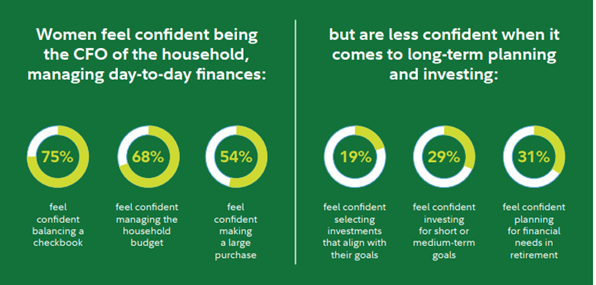
International Women’s Day takes place on 8th March every year. To mark the occasion, I wanted to take a look at why it is that women invest less than men, and also how this pattern is starting to shift as women grow increasingly confident and interested in securing their financial future.
Research has suggested that women are in fact more successful investors than men. So why is it then that fewer of us do it? The answer is quite simple really.
Money has always tended to be a male dominated subject. Women have traditionally been the child bearers and homemakers, whilst men went to work and made the majority, if not all, of the household income. Over time this has left women on the outskirts of ever having to deal with money on a wider scale, and not to mention more reliant on their male counterparts to deal with anything finance related.
However, there is a gradual shift away from this traditionally male swamped field. Fidelity’s 2021 Women and Invest Study highlighted the following:
- 67% of women are now investing outside of retirement (up from 44% in 2018)
- 50% of women say that they are more interested in investing since the pandemic
- 42% of women say they now have more to invest since the start of the pandemic
These are great numbers and ones that should be further encouraged. But there are still big gaps. The same report by Fidelity outlines some interesting statistics:

What the above shows is a lack of confidence in women when it comes to taking the plunge into investing. But when you think about it, managing the household budget is no different to managing investments. It’s exactly the same concept, you’re simply allocating money to different things. It’s the psychological barrier that’s one of the biggest.
So how can we overcome this barrier?
It starts with us at an industry level, you’ll be pleased to hear!
It is our responsibility to make information more accessible to women about the importance of saving and investing.
But it’s also no good making the information available if it doesn’t make sense! It’s no secret that the investment industry uses complicated words that make no sense to someone who isn’t a fund manager with over 30 years’ experience!
I know that when I started working in the industry at 21 years old, the language was completely off putting and I assumed investing was only something that people did if they have a lot of money. Having broken it down I realised that investing really wasn’t that complicated, it’s just made to seem that way.
Some may wonder if investing is even worth understanding and question its importance. For women, investing is arguably even more important than it is for men.
This is because the gender pay gap has in turn led to a pensions gap, with the average woman’s pension pot likely to be 11 per cent smaller (by retirement age) than one held by a man. Yet it is women, with their greater life expectancies, who need to build in longer-term financial security into their planning, which will include pensions as well as other investments. If women really want to be able to achieve their retirement goals, investing isn’t just a lifestyle choice – it’s a necessity.
Sadly, it isn’t until couples get divorced that women often find themselves having to deal with money, and in some cases this is a first-time experience. It can understandably be overwhelming, let alone dealing with the emotional weight of a divorce on its own. It’s never too late to learn about money, saving and investing.
If you would like to find out more about how you can start your investing journey, just get in touch. We have a range of material and expertise here at FundExpert that will be able to shed light on this topic. I will also keep you up to date on future masterclasses and webinars, if you’re interested please email the below.
Email: support@fundexpert.co.uk
The value of your investments and any income from them can fall as well as rise and past performance is not necessarily a guide to future returns. The value of your investment is not guaranteed and on encashment you may not get back the full amount invested. The illustration uses certain assumed rates of growth, as prescribed by the Financial Conduct Authority. These rates are not guaranteed.